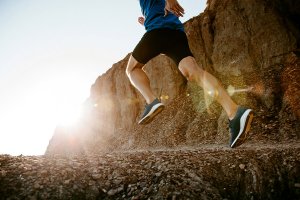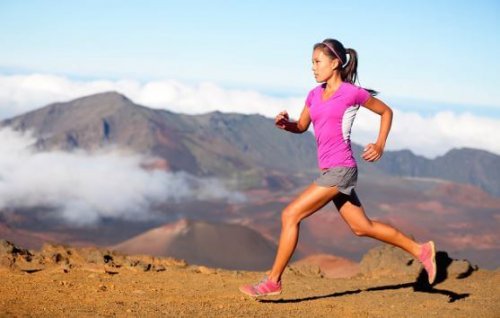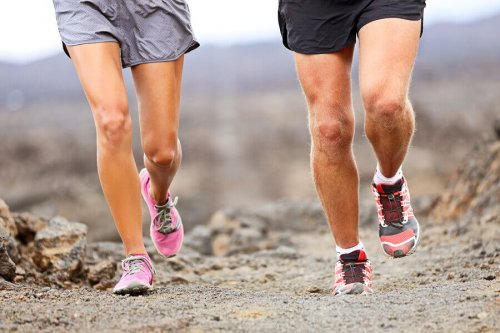Benefits of Mountain Running

If you’re a regular runner, you may be constantly looking for new challenges and choose to carry out your training on different surfaces and terrains, such as mountains. In order to help you stimulate your motivations and improve your physical performance, in this article, we’ll review the benefits of mountain running.
It’s an ideal activity for clearing the mind and enjoying a natural environment. It’s perfect to break the routine and escape the hectic pace and stress of the big cities. As if that weren’t enough, it’s very beneficial for the body, especially at the cardiovascular level, and improves our running pace.
Nonetheless, it’s always advisable for athletes who wish to run in the mountains, to do so when there are good lighting and ideal conditions. Otherwise, the runners are at risk of suffering injuries or having orientation issues.
In any case, mountain running is exceptional because it allows anyone to enjoy the silence and to breathe fresh air while exercising.
Benefits of mountain running
1. An exceptional environment
There’s no doubt that mountain running allows you to immerse yourself in an ideal environment to appreciate the pleasure of running while enjoying the fabulous surroundings.
Regarding health, mountains are less polluted than cities. Hence, running in these landscapes will allow you to boost your performance. You’ll feel much more relaxed once you finish your training sessions!

2. Improves performance
Mountain running requires more uphill ascensions and changes in pace and direction due to the different elevations. During the climbs, you’ll strengthen your muscles, which will make you even more powerful during the road races.
Doing this will cause your muscles to grow and adapt to the inclination and decline of the terrain. You’ll also gain explosive speed by avoiding natural obstacles. After several days of training in the mountains, you’ll notice that you run much faster on flat surfaces.
3. You’ll breathe fresh air
This physical activity allows you to get away from the emanations of the urban centers, which makes it easier to increase the amount, as well as the intensity of the training. Your respiratory system will enjoy the fresh mountain air instead of the constant carbon monoxide emissions from cars that cram the cities.
4. It involves different muscles
Unlike exercising on the asphalt, as most runners do, mountain running offers new angles for the feet that demand more from the muscles that serve to propel you to the next step.
Both the changes in the terrain and the hills that often surround the trails require the participation of different muscle groups more often than simply running on flat roads.
This is a great boost to your resistance and it will work with muscle groups that you didn’t even know you could exercise. Additionally, the buttocks work to a greater extent on a mountain than on a flat surface since your feet must rise higher than during a normal race.
Also, the upper part of the body is more inclined forward than when running horizontally; this posture allows you to work your back muscles as well as your arms and shoulders.

5. You burn more calories while running on a mountain
This great effort you have to exert due to elevation and altitude will help your body burn more calories. If you want to lose weight quickly, you’ll burn fat much faster by doing a high-intensity workout on a mountain than on flat-surface tracks.
In short, mountain running allows you to have a healthy mind and body; as well as providing numerous benefits. If you’re an experienced runner, it can be ideal to break the routine and enjoy a natural environment.
As in any other scenario, don’t forget to carry out a good stretching session before and after each workout. In case you have an injury, you should resume the sport gradually, favoring flat terrain and avoiding downhill runs.
If you’re a regular runner, you may be constantly looking for new challenges and choose to carry out your training on different surfaces and terrains, such as mountains. In order to help you stimulate your motivations and improve your physical performance, in this article, we’ll review the benefits of mountain running.
It’s an ideal activity for clearing the mind and enjoying a natural environment. It’s perfect to break the routine and escape the hectic pace and stress of the big cities. As if that weren’t enough, it’s very beneficial for the body, especially at the cardiovascular level, and improves our running pace.
Nonetheless, it’s always advisable for athletes who wish to run in the mountains, to do so when there are good lighting and ideal conditions. Otherwise, the runners are at risk of suffering injuries or having orientation issues.
In any case, mountain running is exceptional because it allows anyone to enjoy the silence and to breathe fresh air while exercising.
Benefits of mountain running
1. An exceptional environment
There’s no doubt that mountain running allows you to immerse yourself in an ideal environment to appreciate the pleasure of running while enjoying the fabulous surroundings.
Regarding health, mountains are less polluted than cities. Hence, running in these landscapes will allow you to boost your performance. You’ll feel much more relaxed once you finish your training sessions!

2. Improves performance
Mountain running requires more uphill ascensions and changes in pace and direction due to the different elevations. During the climbs, you’ll strengthen your muscles, which will make you even more powerful during the road races.
Doing this will cause your muscles to grow and adapt to the inclination and decline of the terrain. You’ll also gain explosive speed by avoiding natural obstacles. After several days of training in the mountains, you’ll notice that you run much faster on flat surfaces.
3. You’ll breathe fresh air
This physical activity allows you to get away from the emanations of the urban centers, which makes it easier to increase the amount, as well as the intensity of the training. Your respiratory system will enjoy the fresh mountain air instead of the constant carbon monoxide emissions from cars that cram the cities.
4. It involves different muscles
Unlike exercising on the asphalt, as most runners do, mountain running offers new angles for the feet that demand more from the muscles that serve to propel you to the next step.
Both the changes in the terrain and the hills that often surround the trails require the participation of different muscle groups more often than simply running on flat roads.
This is a great boost to your resistance and it will work with muscle groups that you didn’t even know you could exercise. Additionally, the buttocks work to a greater extent on a mountain than on a flat surface since your feet must rise higher than during a normal race.
Also, the upper part of the body is more inclined forward than when running horizontally; this posture allows you to work your back muscles as well as your arms and shoulders.

5. You burn more calories while running on a mountain
This great effort you have to exert due to elevation and altitude will help your body burn more calories. If you want to lose weight quickly, you’ll burn fat much faster by doing a high-intensity workout on a mountain than on flat-surface tracks.
In short, mountain running allows you to have a healthy mind and body; as well as providing numerous benefits. If you’re an experienced runner, it can be ideal to break the routine and enjoy a natural environment.
As in any other scenario, don’t forget to carry out a good stretching session before and after each workout. In case you have an injury, you should resume the sport gradually, favoring flat terrain and avoiding downhill runs.
All cited sources were thoroughly reviewed by our team to ensure their quality, reliability, currency, and validity. The bibliography of this article was considered reliable and of academic or scientific accuracy.
- Ferris, D. P., Louie, M., & Farley, C. T. (1998). Running in the real world: Adjusting leg stiffness for different surfaces. Proceedings of the Royal Society B: Biological Sciences, 265(1400), 989–994. https://doi.org/10.1098/rspb.1998.0388
- McMahon, T. A., Biewener, A. A., Kerdok, A. E., Weyand, P. G., & Herr, H. M. (2015). Energetics and mechanics of human running on surfaces of different stiffnesses. Journal of Applied Physiology, 92(2), 469–478. https://doi.org/10.1152/japplphysiol.01164.2000
- McMahon, T. A., & Greene, P. R. (1979). The influence of track compliance on running. Journal of Biomechanics, 12(12), 893–904. https://doi.org/10.1016/0021-9290(79)90057-5
This text is provided for informational purposes only and does not replace consultation with a professional. If in doubt, consult your specialist.








